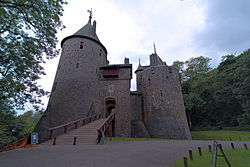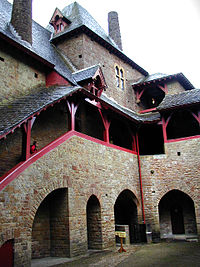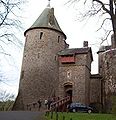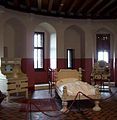Castell Coch
| Castell Coch | |
|
Glamorgan | |
|---|---|
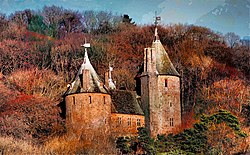 Castle Coch | |
| Type: | Gothic revival |
| Location | |
| Grid reference: | ST130826 |
| Location: | 51°32’9"N, 3°15’17"W |
| Village: | Tongwynlais |
| History | |
| Built 1871-1891 | |
| Information | |
| Condition: | Complete reconstruction |
| Owned by: | Cadw |
Castell Coch is a 19th-century Gothic Revival castle built on the remains of a genuine 13th-century fortification. It stands on a steep hillside high above the village of Tongwynlais, to the north of Cardiff in Glamorgan, and is a Grade I listed building.[1]
The name 'Castell Coch means "Red Castle".
The castle as it stands today was built by the 3rd Marquess of Bute and designed by William Burges with an impressively mediæval appearance, working portcullis and drawbridge, and sumptuous interiors which rival those of Cardiff Castle. It has been described as "the most spectacular example of [Burges's] translation from High Gothic into High Victorian."[2]
Contents
Early history
Castell Coch was built on the site of a 13th-century castle. The earlier fortification was constructed by a Welsh chieftain referred to as Ifor Bach ("Little Ivor"). In the late 13th century the castle site was claimed by the De Clare family because of its strategic importance, commanding both the plains area and the entrance to the Taff valley. The castle was rebuilt in stone and consisted of a keep, towers, an enclosed courtyard and a gatehouse. Although the early history of the castle is largely undocumented, it is generally accepted that it was severely damaged during a period of Welsh rebellion in the early 14th century.[3] Thereafter, the castle fell into disuse and by Tudor times, the antiquary John Leland described it as "all in ruin no big thing but high".[4]
In time, the hill became a popular weekend pot for those heading out from Cardiff and the villages to picnic amongst the romantic ruins.
Reconstruction and resurrection
In 1871, John Crichton-Stuart, 3rd Marquess of Bute, ordered the site to be cleared of vegetation and debris while his architect, William Burges, drew up plans for a full reconstruction. Burges and the Marquess had been working for over three years on the rebuilding of Cardiff Castle; the aim at Castell Coch was to achieve another "dazzling architectural tour de force of the High Victorian era, [a] dream-like castle which combine[d] sumptuous Gothic fantasy with timeless fairy tale."[5]
A set of drawings for the planned rebuilding exists, together with a full architectural justification by Burges. The castle reconstruction features three conical roofs to the towers that are historically questionable. Burges sought to defend their use with references to a body of doubtful historical evidence but: "the truth is that he wanted them for their architectural effect."[6] He did admit that they were "utterly conjectural" although "more picturesque and (...) affording much more accommodation", contending that:
"It is true that some antiquaries deny the existence of high roofs in English Mediæval Military Architecture, and ask objectors to point out examples. As nearly every Castle in the country has been ruined for more than two centuries...it is not surprising that no examples are to be found. But we may form a very fair idea of the case if we consult contemporary (manuscripts) and if we do we find nearly an equal number of towers with flat roofs as those with pointed roofs. The case appears to me to be thus: if a tower presented a good situation for military engines, it had a flat top; if the contrary, it had a high roof to guarantee the defenders from the rain and the lighter sorts of missiles. Thus an arrow could not pierce the roof, but if the latter were absent and the arrow was fired upright, in its downward flight it might occasion the same accident to the defenders as happened to Harold at Hastings."
Burges's report on the proposed reconstruction was delivered in 1872[7] but construction was delayed until 1875, in part because of the pressure of work at Cardiff Castle, and in part because of an unfounded concern on behalf of the Marquess's trustees that he was facing bankruptcy.[8] But in August 1875 work began in earnest. The exterior comprises three towers, "almost equal to each other in diameter, (but) arrestingly dissimilar in height."[4] They form an awesome display of architectural power and ability. In a lecture, Burges called on architectural students to "study the great broad masses, the strong unchamfered lines".
The Keep tower, the Well Tower and the Kitchen Tower incorporate a series of apartments, of which the main sequence, the Castellan's Rooms, lie within the Keep. The Hall, the Drawing Room, Lord Bute's Bedroom and Lady Bute's bedroom comprise a suite of rooms that exemplify the High Victorian Gothic style in 19th century Britain. They begin weakly: the Banqueting Hall, completed well after Burges's death, is "dilute(,...) unfocussed"[9] and "anaemic."[2] The Drawing Room is "more exciting",[9] a double-height room with decoration illustrating the "intertwined themes (of) the fecundity of nature and the fragility of life."[10] A superb fireplace by Thomas Nicholls features the Three Fates, spinning, measuring and cutting the thread of life.[11] The octagonal chamber with its great rib-vault, modelled on one designed by Viollet-Le-Duc at Councy, is "spangled with butterflies and birds of sunny plume in gilded trellis work."[12] Off the hall, lies the Windlass Room, in which Burges delighted in assembling the fully functioning apparatus for the drawbridge, together with "murder holes" for expelling boiling oil.[13] The Marquess's bedroom provide some "spartan"[14] respite before the culmination of the castle, Lady Bute's Bedroom.
The room is "pure Burges: an arcaded circle, punched through by window embrasures, and topped by a trefoil-sectioned dome."[14] The decorative theme is 'love', symbolised by "monkeys, pomegranates, nesting birds".[14] The decoration was completed long after Burges's death but his was the guiding spirit; "Would Mr Burges have done it?" William Frame wrote to Thomas Nicholls in 1887.[14]
Following Burges' death in 1881, work on the interior continued for another ten years. The castle was not used much: the Marquess never came after its completion, and the family appeared to use it as a sort of sanatorium, although the Marchioness and her daughter, Lady Margaret Crichton-Stuart, did occupy it for a period following the death of the Marquess in 1900. But the castle remained "one of the greatest Victorian triumphs of architectural composition,"[15] summing up "to perfection the learned dream world of a great patron and his favourite architect, recreating from a heap of rubble a fairy-tale castle which seems almost to have materialised from the margins of a mediæval manuscript."[14]
In 1950, the 5th Marquess of Bute placed the castle in the care of the Ministry of Works. It is now administered by Cadw. The castle is Grade I listed, as it is of exceptional architectural and historical interest.
Site of Special Scientific Interest
The area surrounding the castle is notable both for the ancient beech woods and for the rock outcrops, which show the point where Devonian Old Red Sandstone and Carboniferous Limestone beds meet. The area is designated the Castell Coch Woodlands and Road Section Site of Special Scientific Interest.[16]
Media appearances
The castle has been much used for filming, including:
- The Black Knight (1954), starring Alan Ladd
- Gawain and the Green Knight (1973)
- The Scarlet Pimpernel (1982)
- The Prisoner of Zenda, (BBC, 1984)
- and on television
- The Worst Witch
- The Story of Tracy Beaker (television series) ('Tracey Beaker's Movie Of Me')
- Robin Hood
- Doctor Who in the episodes Journey's End, The Vampires of Venice and Nightmare in Silver
- Merlin in the episode 'The Changeling'
- Da Vinci's Demons
- Heston's Great British Food
Pictures
Outside links
| ("Wikimedia Commons" has material about Castell Coch) |
References
- ↑ Castell Coch - British Listed Buildings
- ↑ 2.0 2.1 William Burges and the High Victorian Dream, p. 281
- ↑ Castle Coch: Official Guide, p. 10
- ↑ 4.0 4.1 The Buildings of Wales: Glamorgan, p. 315
- ↑ Castle Coch: Official Guide, p. 3
- ↑ The Victorian Country House, p. 340
- ↑ Castle Coch: Official Guide, p. 22
- ↑ Castle Coch: Official Guide, p. 24
- ↑ 9.0 9.1 The Buildings of Wales: Glamorgan, p. 317
- ↑ The Buildings of Wales: Glamorgan, p. 318
- ↑ Castle Coch: Official Guide, p. 41
- ↑ William Burges and the High Victorian Dream, p. 282
- ↑ Castle Coch: Official Guide, p. 45
- ↑ 14.0 14.1 14.2 14.3 14.4 William Burges and the High Victorian Dream, p. 283
- ↑ Castle Coch: Official Guide, p. 31
- ↑ link page for Castell Coch SSSI citation accessed 19 Feb 2012
- Girouard, Mark (1979). The Victorian Country House. Yale University Press.
- Floud, Peter (1980). Castell Coch: Official Guide. Welsh Office.
- Crook, J. Mordaunt (1981). William Burges and the High Victorian Dream. John Murray.
- Crook, J. Mordaunt (1981). The Strange Genius of William Burges. National Museum of Wales.
- McLees, David (2005). Castell Coch: Official Guide. Cadw.
- Newman, John (1995). The Buildings of Wales: Glamorgan. London, UK: Penguin.
